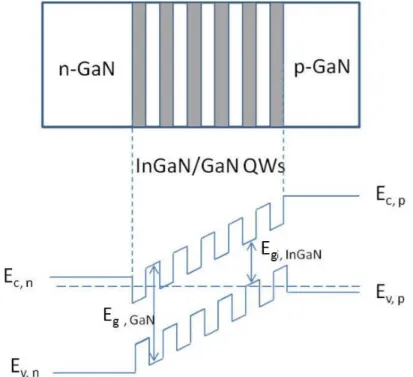InGaN/GaN Multiple Quantum Wells for Photovoltaics
Texte intégral
Figure

![Figure 2.1. Spectral power density of the Sun as a function of the wavelength: on the Sun surface (dotted line), in the space (AM0 radiation) and on the Earth surface (AM1.5 radiation) [Green, 1982]](https://thumb-eu.123doks.com/thumbv2/123doknet/12850256.367855/27.892.204.690.129.445/figure-spectral-density-function-wavelength-surface-radiation-radiation.webp)

Documents relatifs
The dependence of the InGaN/GaN SQW optical properties with the thickness of the InGaN UL suggests the following mechanism: SDs are incorporated if In atoms are present at the
It was reported that such gross indium-rich clusters may, in fact, be pure InN [11], and pure InN regions with a 1-3 nm size were reported in InGaN quantum wells grown by both
Abstract: In this work, the solar power conversion efficiency of InGaN/Si double junction tandem solar cells was investigated under 1-sun AM1.5 illumination, using realistic
To quantify the luminescence enhancement obtained with the metallic grating, two QW luminescence spectra were recorded and compared: one when the laser pumping spot was focused under
The authors have applied modulation spectroscopy to study intersubband (IS) and interband (IB) transitions in InGaN/AlInN multi quantum well (QW) structures with the QW width
At the few nanometre scale, the concept of indium clustering remains controversial, and for blue- and green-emitting quantum wells with indium contents up to about 25% there is
As the carrier concentration increases, the Ohmic contacts improve, but worse rectifying properties are obtained for Schottky contacts and no meaningful C-V measurements are



![Figure 2.16. Current density-voltage measurements of The images are taken from a) [Yamamoto, 2008], inset sh [Jampana(1), 2010]](https://thumb-eu.123doks.com/thumbv2/123doknet/12850256.367855/46.892.126.786.491.804/figure-current-density-voltage-measurements-images-yamamoto-jampana.webp)
![Figure 2.19. a) InGaN/GaN solar cell device structure; b) J-V characteristics under 1.5 sun AM1.5G illumination [Kuwahara(2), 2010]](https://thumb-eu.123doks.com/thumbv2/123doknet/12850256.367855/49.892.122.776.540.806/figure-ingan-solar-device-structure-characteristics-illumination-kuwahara.webp)